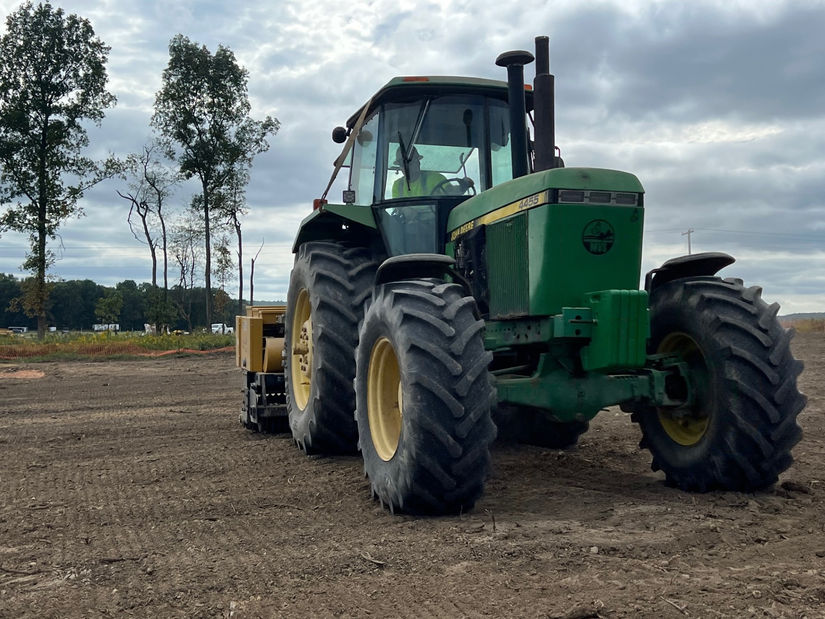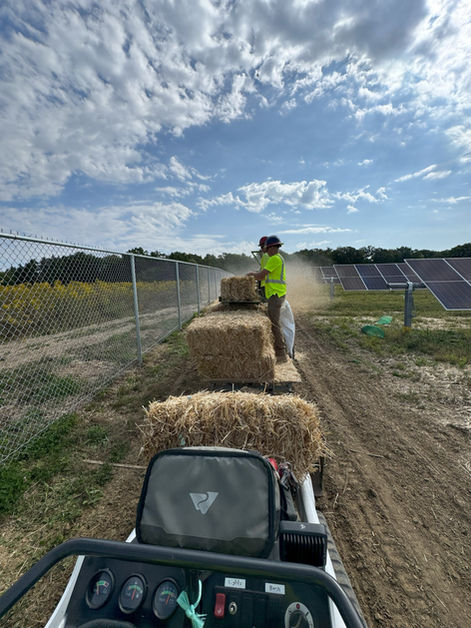
RECENT PROJECTS
MI Automotive Manufacturer Solar Project
This 33-acre solar project in MI is one we are excited to see progress over the next couple years. Due to unfortunate weather conditions, we had to push seeding off from our initially planned start date, but the client was willing to wait for the next ideal growing season to ensure the best outcome for establishment on this custom pollinator mix. Though this process will take a bit more time and effort, we cannot wait to show you the difference in results when a site is properly prepped and stabilized as well as maintained for a specialized pollinator mix such as this. Stay tuned for updates and photos as this site progresses!
PA Solar Projects
We were honored to be selected to perform the seed installation for 2 different sites in PA for this client. With a combined total of 150 acres for these sites, and a variety of existing site conditions such as areas of open farm field along with areas that had been cleared of existing forest, we performed several soil tests to analyze the standing soil conditions across all areas of these sites. As suspected, amendments would be needed in order to get this soil in suitable condition prior to cover crop and permanent seed installation. These sites have 2 separate Ernst Conservation Seed mixes that differ substantially (ERNMX-186 & ERNMX-105), but both still offer pollinator benefits. Be on the lookout for updates on these sites as they establish!
10 Site PA Portfolio
MVS was selected to perform the seeding installation for all 10 solar sites within this portfolio in PA. Collectively totaling 215 acres, these sites are all located in close proximity to our shop in Northwestern PA. MVS was also able to perform some mowing maintenance on these sites prior to seed installation, due to the existing vegetation conditions and to ensure proper seed to soil contact when installing the permanent seed mixes selected by the client. We look forward to the progression of work on these sites and overall vegetative outcome and will provide updates as work continues!
Spotsylvania Solar Project
The Spotsylvania Solar project in VA is still to date the largest solar site MVS, Inc has been on. MVS, Inc was one of four seeding contractors during our off and on work schedule over the course of two years. MVS, Inc was able to establish great vegetation on this site with the help of Ernst Seed and Chesapeake Valley Seed to coordinate beneficial vegetation on these tough soils. With the proper soil amendments and the right seed, even poor-quality soils can provide a level of Pollinator value that turf grasses alone cannot. With a combination of seed bed preparation followed by hydro mulching or straw mulching, MVS, Inc was able to turn tight, compacted clay soils into a lush, vegetated site.
Solar Project 1
The existing conditions photo shows what we had to work with after construction of the solar field was complete. Some areas of overly compacted soils while other areas had overgrowth. A combination tillage and herbicide were needed to prepare this area for seeding.
The First Year Establishment in this photo shows how poor soils in a drought year can impact early establishment. Mowing maintenance is critical in cases like this. Cutting the existing vegetation down to 8” opens the canopy and allows those struggling seedlings to see the sun once you have cut back the competition. This can be a difficult stage to judge success. It may not look like much is going on, but patience can be a virtue.
Remember the First Year Establishment photo? Things have changed by now. Maintenance and patience are starting to pay off. Maintenance mowing and if needed, herbicide spot spraying, are critical components to a successful pollinator establishment. It’s not enough to just plant the seed and walk away.
Solar Project 2
The associated photos depict 3 stages of pollinator establishment.
In the Existing Conditions photo, the site is vegetation by existing cool season species such as Fescues, Kentucky Blue Grass, and Clovers. First step to get better vegetative site control with herbicide to kill existing vegetation before seeding.
The First Year Establishment photo shows how some native species can provide aesthetic value in the first growing season, even in a drought year if the site has the right soil. Biennial and annual species like the Black eyed Susans and Partridge Pea seen in this photo can offer some early eye candy while the perennial species are focused on root development before revealing their blooms in the coming years. Even though we have some blooms in the first year of establishment, mowing maintenance remains the most important tool to encourage better establishment of all those little perennial seedlings that are hard to pick out at this stage. Opening that vegetation canopy to let the light in is a must.
Second Year Establishment is when things begin to come alive. While herbicide spot spray may be needed in certain areas, plant densities really drive management practices at this stage. Evaluating densities of the pollinators and deciding if mowing is needed is important. Differing seed dormancy can affect early aesthetic and establishment. Additional mowing may be needed at this point if native species are observed in low densities. You could still have small perennial seedlings down in there that are trying to fill in but need a little help.
Cople Elementary School
Cople Elementary School in Westmoreland County is the first facility in Virginia to be gold certified under a new program that encourages pollinator-friendly solar development. Gold certification is the highest pollinator-smart designation available through the voluntary program.
Catholic Charities
Catholic Charities is the largest ground mounted solar project to date in Washington, DC. “You’re not only harnessing the gift of sunlight to create clean power for the benefit of so many, but you’re also enriching the ground.” – Page Gravely, Catholic Energies.
Giant Foods
Monarch Vegetation Services Inc. was honored to have the opportunity to seed and plant in and around the Giant array while also providing critical habitat for pollinators. As the field matures over the years, more than one million pollinator plants will feed native bees and help pollinate local farm fields. The field includes more than 20 varieties of wildflowers native to the northeast and central Pennsylvania like Butterfly Milkweed, Mountain Mint, Blue Mistflower and Golden Alexander.























































